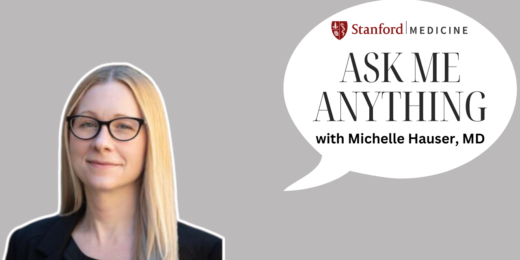Feeling anxious? You're far from alone. During the pandemic, rates of anxiety and depression soared around the globe, resulting in a shortage of mental health care providers and long wait times for therapy.
But, according to a new study from Stanford Medicine, there's an easy, at-home way to help lower your stress level: It's called cyclic sighing, a controlled breathing exercise that emphasizes long exhalations. What's more, it can take as little as five minutes to experience less anxiety, a better mood and even decreased rates of breathing at rest, a sign of overall body calmness.
"What's interesting about the breath is that it's right on the edge of conscious control," said David Spiegel, MD, the Jack, Lulu, and Sam Willson Professor in Medicine and associate chair of psychiatry and behavioral sciences, who co-led the study with Stanford Medicine neurobiologist Andrew Huberman, PhD, and Melis Yilmaz Balban, PhD, former Stanford Medicine senior research scientist. "Most of the time breathing is automatic, like digestion, heartbeat and other bodily functions, but you can very easily take over and control your breath, which then affects your overall physiology and stress response."
Breaking the anxiety spiral
Imagine you've just experienced something stressful -- maybe a critical email from your boss or a phone call from your child's school principal. As soon as you start to worry, your heart rate speeds, and you breathe a little more quickly. Your muscles tighten, your armpits get sweaty and you suddenly feel restless and fidgety.
For many people, especially those with anxiety disorders, these physical changes trigger a chain reaction of thoughts and fears, said Spiegel, who is the director of the Center on Stress and Health at Stanford Medicine. "As soon as you notice what's going on in your body, your brain thinks, 'Oh no, this must be really bad,' and you get more anxious. It's like a snowball rolling downhill."
But taking charge of your breathing can break the cycle, Spiegel said. "When we teach people to control the physical effects of a stressor on their body, it puts them in a better position to deal with the stressor itself."
The instructions are simple: Breathe in through your nose. When you've comfortably filled your lungs, take a second, deeper sip of air to expand your lungs as much as possible. Then, very slowly, exhale through your mouth until all the air is gone.
After one or two of these deep sighs, you may already feel calmer, but to get the full effect, Spiegel recommends repeating these deep sighs for about five minutes. Exhalation activates the parasympathetic nervous system, he said, which slows down heart rate and has an overall soothing effect on the body.
Putting cyclic sighing to the test
There's a long history of using controlled breathing in traditional practices like yoga, tai chi and meditation, but scientists are just beginning to study how these breathing exercises work and which ones are most beneficial.
Huberman and Spiegel recently led a randomized, controlled trial of cyclic sighing compared to two other types of breathing exercises, one emphasizing inhalation and another asking participants to breathe in and out for equal amounts of time. Each of the 111 healthy volunteers were asked to perform their assigned exercise for five minutes a day over the course of one month. (People with moderate to severe psychiatric conditions were not a part of this preliminary study.)
Before and after completing their daily breathing exercises, participants answered two online questionnaires: the State Anxiety Inventory, a standardized measurement of current anxiety levels, and the Positive and Negative Affect Schedule, a common research tool used to assess good and bad feelings on a scale from 1 to 5.
The trial also included a control group of participants who passively observed their breath during five minutes of mindfulness meditation.
"In mindfulness meditation, we instruct people to be aware of their breath but not try to control it," Spiegel said. "For the other groups, we asked participants to directly control an activity that normally goes on more or less automatically."
Hundreds of studies have demonstrated the benefits of mindfulness meditation for reducing stress and anxiety, and as expected, the mindfulness group reported lower anxiety and improved mood. But in this study, published Jan. 17 in Cell Reports Medicine, the controlled breathing groups reported even more improvements, with significantly greater increases in positive affect -- good feelings such as energy, joy and peacefulness.
On average, participants in the controlled breathing groups experienced a daily increase in positive affect of 1.91 points on the Positive and Negative Affect Schedule scale, compared to 1.22 points for the mindfulness meditation group, an improvement that's greater by about one-third.
"Controlled breathing exercises may have a more rapid, more direct effect on physiology than mindfulness," Spiegel said, noting that people typically meditate for 20 to 30 minutes at a time. "We wanted to see whether a quicker intervention, repeated for just five minutes over the course of 30 days, could still have lasting effects."
The researchers also hypothesized that cyclic sighing, with its focus on slow exhalation, might be more effective than the other two types of controlled breathing.
Indeed, while all three controlled breathing interventions decreased anxiety and negative mood, participants in the cyclic sighing group had the greatest daily improvement in positive feelings on the Positive and Negative Affect Schedule questionnaire. The effect increased as the study went on, suggesting that the more consecutive days they practiced cyclic sighing, the more it helped their mood.
Slower breathing rate, calmer body
In addition to tracking anxiety and mood, participants wore sensors to monitor their resting breathing rate and heart rate. Although no changes to heart rate were observed in any of the groups, participants in the cyclic sighing group significantly lowered their resting breathing rate, more than the mindfulness or other controlled breathing groups.
"They were breathing more slowly not just during the exercise, but throughout the day, indicating a lasting effect on physiology," Spiegel said.
Respiratory rate was also inversely correlated with a change in positive affect, suggesting that the participants whose breathing slowed down the most were also the ones who experienced the greatest improvement in mood.
"We know that people who are breathing very rapidly feel more anxious, such as during a panic attack," Spiegel said. "Controlled breathwork seems to be a straightforward way to do the opposite: lower physiologic arousal and regulate your mood."
Simple, quick and free
One of the best parts of cyclic sighing is that it can be done anytime, anywhere -- with zero cost and zero side effects. In fact, due to the pandemic, the team conducted the entire trial remotely.
"Now we know we can reach a much bigger and more diverse population than if we'd done everything in the lab," said Spiegel.
In the future, Spiegel and Huberman plan to use functional MRI to measure brain activity during the controlled breathing exercises, and they hope to conduct treatment studies in specific populations with anxiety or mood disorders.
"There's a growing interest in nonpharmacological ways of helping people regulate their mood," Spiegel said. "We may be able to identify certain kinds of anxiety that respond substantially to this simple treatment."
In the meantime, Spiegel says there's no harm in trying cyclic sighing for yourself.
Photo by Fokussiert






